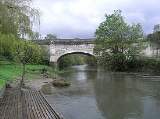
Avoncliff Aqueduct
Encyclopedia
Avoncliff Aqueduct carries the Kennet and Avon Canal
over the River Avon
and the Bath to Westbury
railway line, at Avoncliff
in Wiltshire
, England
.
It was built by John Rennie
and chief engineer John Thomas, between 1797 and 1801.
The aqueduct
consists of three arches and is 110 yards long with a central elliptical arch of 60 ft (18.3 m) span with two side arches each semicircular and 34 ft (10.4 m) across, all with V-jointed arch stones. The spandrel and wing walls are built in alternate courses of ashlar masonry, and rock-faced blocks. The central span sagged soon after it was built and has been repaired many times.
As part of the restoration of the canal the aqueduct was lined with a concrete "cradle" and made water-tight in 1980.
Kennet and Avon Canal
The Kennet and Avon Canal is a waterway in southern England with an overall length of , made up of two lengths of navigable river linked by a canal. The name is commonly used to refer to the entire length of the navigation rather than solely to the central canal section...
over the River Avon
River Avon, Bristol
The River Avon is an English river in the south west of the country. To distinguish it from a number of other River Avons in Britain, this river is often also known as the Lower Avon or Bristol Avon...
and the Bath to Westbury
Westbury, Wiltshire
Westbury is a town and civil parish in the west of the English county of Wiltshire, most famous for the Westbury White Horse.-Name:The most likely origin of the West- in Westbury is simply that the town is near the western edge of the county of Wiltshire, the bounds of which have been much the same...
railway line, at Avoncliff
Avoncliff
Avoncliff is a village in Wiltshire.It is the point at which the Kennet and Avon canal crosses the river and railway line via the Avoncliff Aqueduct, which was built by John Rennie and chief engineer John Thomas, between 1797 and 1801...
in Wiltshire
Wiltshire
Wiltshire is a ceremonial county in South West England. It is landlocked and borders the counties of Dorset, Somerset, Hampshire, Gloucestershire, Oxfordshire and Berkshire. It contains the unitary authority of Swindon and covers...
, England
England
England is a country that is part of the United Kingdom. It shares land borders with Scotland to the north and Wales to the west; the Irish Sea is to the north west, the Celtic Sea to the south west, with the North Sea to the east and the English Channel to the south separating it from continental...
.
It was built by John Rennie
John Rennie (father)
John Rennie was a Scottish civil engineer who designed many bridges, canals, and docks.-Early years:Rennie, a farmer's younger son, was born at Phantassie, near East Linton, East Lothian, Scotland, and showed a taste for mechanics at a very early age, and was allowed to spend much time in the...
and chief engineer John Thomas, between 1797 and 1801.
The aqueduct
Aqueduct
An aqueduct is a water supply or navigable channel constructed to convey water. In modern engineering, the term is used for any system of pipes, ditches, canals, tunnels, and other structures used for this purpose....
consists of three arches and is 110 yards long with a central elliptical arch of 60 ft (18.3 m) span with two side arches each semicircular and 34 ft (10.4 m) across, all with V-jointed arch stones. The spandrel and wing walls are built in alternate courses of ashlar masonry, and rock-faced blocks. The central span sagged soon after it was built and has been repaired many times.
As part of the restoration of the canal the aqueduct was lined with a concrete "cradle" and made water-tight in 1980.
See also
- Dundas AqueductDundas AqueductDundas Aqueduct carries the Kennet and Avon Canal over the River Avon and the Wessex Main Line railway from Bath to Westbury, near Limpley Stoke in Wiltshire, England....
- Locks on the Kennet and Avon CanalLocks on the Kennet and Avon CanalThe Kennet and Avon Canal is a canal in southern England. The name may refer to either the route of the original Kennet and Avon Canal Company, which linked the River Kennet at Newbury to the River Avon at Bath, or to the entire navigation between the River Thames at Reading and the Floating...
- List of canal aqueducts in Great Britain
- Canals of Great Britain

